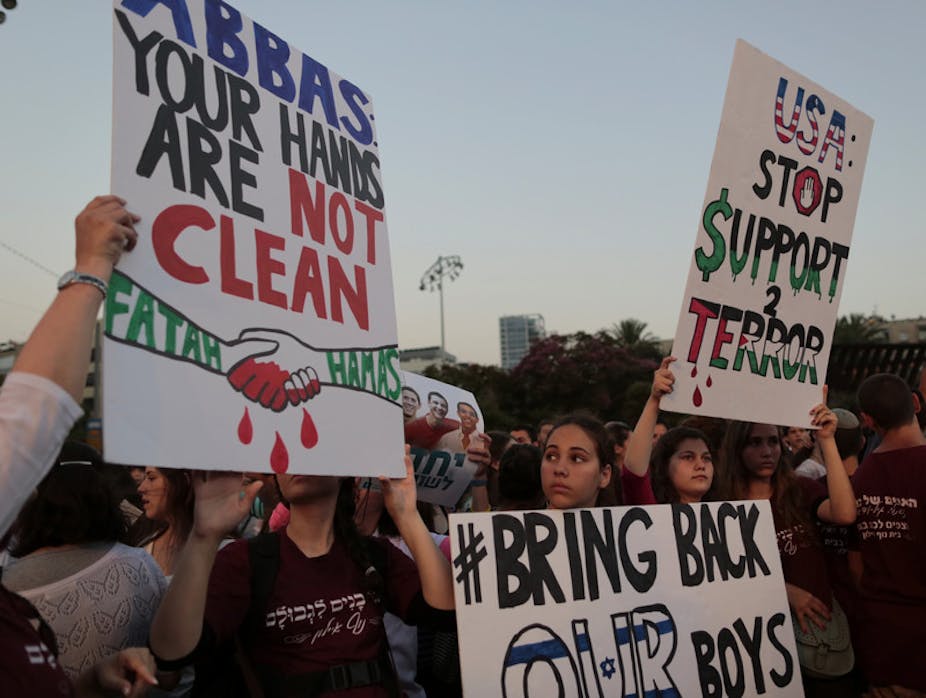The discovery of the bodies of three kidnapped Israeli teenagers – Eyal Yifrah, 19, Naftali Frenkel, 16, and Gilad Shaar, 16 – in the West Bank town of Halhul has left relations between Israel and the Palestinian territories near breaking point.
Late into the night on June 30, air strikes hit 34 sites in Gaza, while the families of the two men accused of the abduction of the boys, Amer Abu Eisha, 29, and Marwan al-Qawasmeh, 33, were removed from their homes as security forces prepared to demolish the buildings.
In the Knesset, divisions on how the state should respond prompted prime minister Benjamin Netanyahu to delay the vote and schedule a second meeting.
The news provoked unanimous censure from international leaders, as Barack Obama condemned “the senseless act of terror against innocent youth”, while David Cameron defined the killings as an “appalling and inexcusable act of terror perpetrated against young teenagers”.
Despite the debate’s delay, retaliation has emerged as a dominant discourse and has marked the actions that have taken place since the disappearance of the boys on June 12.
Revenge at any cost
Former Otzma LeYisrael and National Union Knesset member Michael Ben-Ari led calls for immediate action with a Facebook-issued statement and video, in which he called for Ramadan to be “a month of darkness”, while the minister of the economy, Naftali Bennett, responded, “We will ultimately be at war in Gaza. It’s better that we be the ones to start it.”
Since the teenagers’ disappearance, 400 Palestinians suspected of holding links to Hamas have been arrested and jailed in the West Bank. But information regarding the whereabouts of the group, who were hitchhiking back from their school near Hebron, remained elusive.
While it has been suggested that the kidnapping of Yifrah, Frenkel and Shaar was inspired by the abduction of Israeli soldier Gilad Shalit by Hamas in 2006, the absence of demands issued by the kidnappers and Hamas’s continued denial of involvement leave the nature of the actors and motives behind it open to question.
The abduction and killings have occurred less than a year after the disappearance and murder of off-duty Israeli soldier Tomer Hazan in September 2013, which was itself followed 48 hours later by the killing of the IDF soldier Gal Gabriel Kobi in Hebron.
In the case of Hazan, Nidal Amar confessed to killing the soldier with the intention of trading Hazan’s body for the release of his brother, who had been jailed in 2003 for his involvement in a number of terror attacks.
Amar’s actions were apparently non-political; after his arrest his family maintained that “he never told us about his plans” and had returned to the family home after two years’ absence. Nevertheless, his actions found resonance in the broader context of the conflict – and just as the deaths in September 2013 put a severe strain on relations during the peace talks, the current case places hopes for positive progress on hold.
The bigger picture
As talks in the Knesset recommence, the crux of the matter is the question of how to proceed.
The strikes on Gaza have sent a swift, retaliatory message to Hamas, but whether that message has reached the intended recipients remains to be seen. After all, it is civilians who receive the punishment.
An alternative contention resides in the construction of further settlements between Alon Shvut and Beitar Ilit, in the names of Yifrah, Frenkel and Shaar.
Proposed by defence minister Moshe Ya'alon and Netanyahu, the construction of additional settlements, against international law, would not assuage further conflict, but rather ensure that peace slips even further out of reach.
As settler violence against Palestinians in the West Bank goes on – last week settlers from Psagot opened fire at mourners following the funeral procession of a Palestinian killed by Israeli forces the previous weekend – tensions and distrust will continue to dominate the political landscape.
That the teenagers’ killings occurred in Hebron attests to the broader tensions in the increasingly militarised area. Hebron’s residents were informed last month that mediations on the establishment of Firing Zone 918 will be extended for another three months, while military exercises around the villages of Jinba and Mirkez have continued.
Although a solution has been offered under which the Palestinian residents could vacate their properties for 30 months while exercises are carried out, the residents will have no alternative location to live during the interim period. In the meantime, they reside in a firing zone as the legal proceedings wear on.
False sense of security
The proposal for additional settlements comes shortly after the Israeli government approved a $86 million security plan for East Jerusalem, which will be carried out under Bennett over the coming five years.
Under the Mendelblit Report amendments would be sought to enhance the punitive powers of the penal code, allowing for “stiffer penalties”, as well as providing additional security cameras and police officers. However, of the sum allocated, only 10% will be dedicated to improving the infrastructure of the area.
And despite increased security apparatus and funding, the state’s response to the killings lays the foundation for further instability. As daily acts of violence and repression are committed on both sides, lasting security is just a dream. All that remains are the catalysts for more violence.

